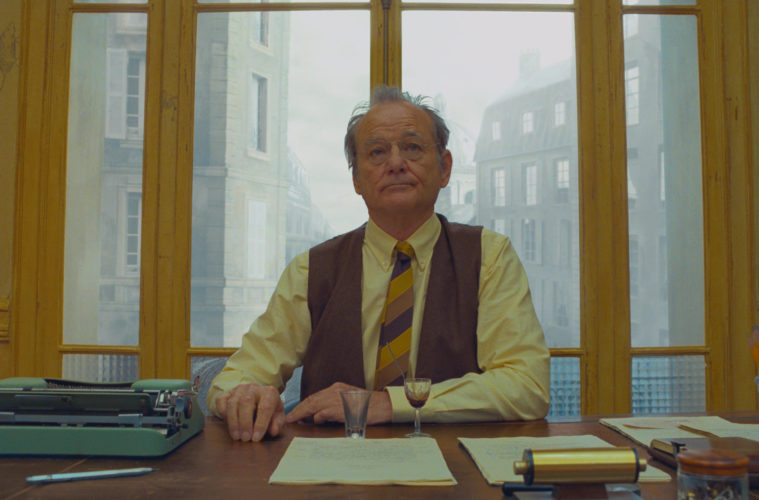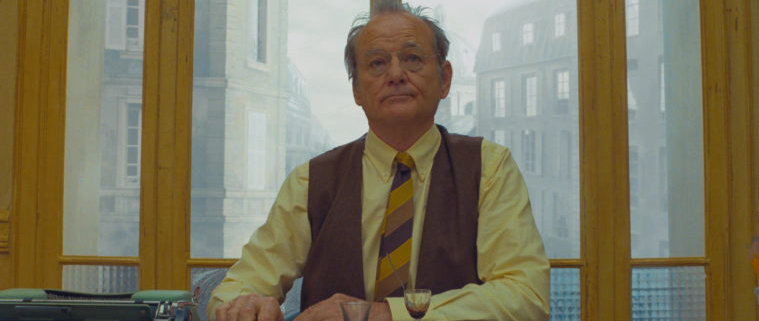‘The French Dispatch’ is visual language at its finest

Like a magazine, Wes Anderson’s latest film “The French Dispatch” reads as a thoughtful, poetic display of the written word. A story about journalists first and foremost, the film showcases stories in and around France through the lens of the foreign correspondents writing them. By translating written stories to a cinematic format, “The French Dispatch” demonstrates an effortless mastery of visual storytelling.
The film situates itself in Ennui-sur-Blasé, a fictional French town where the staff of “The French Dispatch” — the French bureau of a Kansas-based newspaper — are getting ready to publish its final issue after the death of its editor Arthur Howitzer Jr. (Bill Murray). The journalists’ stories for the magazine serve as the subjects of the film.
Roughly three largely disparate stories make up the entirety of “The French Dispatch,” and they correspond to different sections of the magazine: arts, politics and food. The first story is a romance between an incarcerated artist named Moses Rosenthaler (Benicio Del Toro) and his prison guard Simone (Léa Seydoux). Another has a more political angle, featuring journalist Lucinda Krementz (Frances McDormand) developing a relationship with Zeffirelli, the young chess prodigy and activist she’s profiling (Timothée Chalamet). The third story is about a food writer, Roebuck Wright (Jeffrey Wright) who gets wrapped up in a kidnapping in the process of interviewing a chef (Stephen Park).
True to the work of its journalistic subject matter, “The French Dispatch” unravels the different layers of a story with striking precision. The film imitates the artistic form of magazine storytelling through the incorporation of multimedia elements. One chase sequence in the third story, for example, is depicted entirely through an animated cartoon. Drawing on voiceover narration, drawings and aesthetic cinematography, “The French Dispatch” feels very much like an accompanying video feature to a print story. In many ways, it is.
Aesthetically, Anderson’s style has much to marvel at: The bright colors in the background are visually appealing and at the forefront of the film. Settings are whimsical and dynamic enough that they allow for a meaningful degree of escapism. Sometimes those colors are swapped out in favor of black-and-white, but those decisions add their own evocative flair.
The characters’ dialogue, too, is biting and humorous. It’s undeniably fun just how quickly Zeffirelli and fellow rebel Juliette (Lyna Khoudri) are able to bounce off one another in their conversations about the student revolution. English and French are both used in these debates, indicating a cross-cultural perspective to Anderson’s cinematic rendering.
In all the other stories, one just can’t help but eagerly anticipate the responses to witty remarks. Language is the film’s obvious strength. There’s a clear rhythm to the banter that “The French Dispatch” executes particularly well.
Of course, the sheer amount of stories can also feel disorienting. For those who aren’t as familiar with the fast-paced nature of an Anderson film, the subplots can be distracting — and bordering on convoluted. Brevity is at the core of journalism, and sometimes that concision feels lacking in the film. The kidnapping plot in particular is haphazard enough that it no longer feels purposeful. It’s easy to get lost in such swerves, as if the original article — or script in this case — didn’t undergo enough editing.
Furthermore, a few minor characters are briefly dismissed without explicit significance to the story’s plot. With these incoherencies, it’s difficult to understand why these characters were ever included in the first place.
In many ways, that idea does tell us a lot about journalism. Narrative, much like “The French Dispatch,” can be imperfect, even messy. At its core, journalism is about the story. Stories aren’t linear. When the film jumps from one character to another, it also references the narrative medium itself. In the second story, there’s a reflexive element to Lucinda’s presence documenting Zeffirelli, as the concept of journalistic neutrality is hotly debated. Ethical questions are posed about what the role of the journalist is. Both editing and writing are questioned in relation to how these practices shape a story.
Storytelling is a gift, and “The French Dispatch” tells stories within stories. Sure, those stories sometimes have a few places where sentences could be tighter, structures could be adjusted and whole paragraphs could be cut out. Even with those flaws, they’re gifts, nonetheless, neatly wrapped up in Anderson’s stylistic filmmaking and presented to the audience as a reminder of why arts and culture are so incredibly important.
As a representation of arts and culture at their best, it’s no question that “The French Dispatch” is a story in and of itself. In fact, it’s a story about storytellers, and that might just be the most powerful form of storytelling there is.

